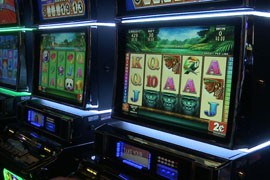
Casinos in Arizona now operate 14,451 slot machines, 297 blackjack tables, 191 poker tables, 67 other gaming tables and 11 bingo halls making casinos one of the larger industries in the state in terms of income. (Cronkite NewsWatch file photo)

Click on image to see full list of Arizona casinos and the games they run. (Cronkite News Service graphic by Joshua Armstrong)

Casinos raked in $1.7 billion in fiscal 2011, putting them well ahead of receipts for cattle, cotton and citrus – three of the Five C’s, with copper and climate, that were recognized as traditional drivers of the Arizona economy. (Cronkite NewsWatch file photo)
By JOSHUA ARMSTRONG
Cronkite News Service
WASHINGTON – The “Five C’s” that traditionally made the bulk of Arizona’s economy – copper, climate, cattle, cotton, citrus – may need to make room for a sixth: casinos.
Revenue from Arizona’s 22 casinos far surpassed cattle, cotton and citrus in the most recent figures available for each. Casinos took in nearly $1.7 billion during fiscal 2011, which ended June 30, according to the Arizona Department of Gaming’s annual report.
By comparison, cattle industry receipts totaled $637 million in 2010 and another $650 million from dairy products. Cotton receipts bounced back from a poor 2009, but the crop’s $206 million take was just a fraction of casino wins. And although Arizona’s biggest citrus crop, lemons, accounted for nearly 10 percent of U.S. production, it produced just $34 million in receipts.
Casinos are the largest part of an Arizona gaming industry that exceeded $2 billion when Arizona Lottery games – including Powerball and scratch-off tickets – were included. The lotteries grossed $584 million in fiscal 2011.
Still, while Arizona’s casino industry is gaining on the traditional drivers of the state economy, the Five C’s aren’t what they used to be. All six C’s were a small part of Arizona’s $253 billion gross domestic product in 2010 and have long since taken a backseat to real estate and manufacturing.
Tribal casinos – Arizona’s only kind – have succeeded because they bring betting to people who are unlikely to make a trip to a Las Vegas or Atlantic City, said Alan Meister of Nathan Associates. Meister is an economist who studies tribal gaming.
“What Indian casinos did, they brought gaming closer to the customers,” he said. “Tribes really have grown the market.”
And tribes are betting there’s more cash to reap. The Tohono O’odham plan a new resort in Glendale and the Pascua Yaqui opened an expansion of their Casino Del Sol in Tucson in November.
But unlike the Five C’s, the positive economic impacts of gaming might be muted by the nature of who the gamblers are and how they typically spend, according to Dennis Hoffman, a professor with Arizona State University’s W.P. Carey School of Business.
“My sense is that most (gaming money) is spent by residents, so this is just a churn of local dollars,” Hoffman wrote in an e-mail. “A dollar spent on gaming means one less dollar spent on some other local activity.
“Indeed, cattle, cotton and citrus aren’t as significant in the state today, but touting gaming as key to economic prosperity using these numbers is a stretch,” he wrote.
The three Arizona counties without Indian gaming have seen a decline in dollars from tourists and locals, who leave the county for the entertainment and dining at casinos, said Robert Carreira, director of the Cochise College Center for Economic Research in Sierra Vista.
The eastern agricultural towns of Cochise County don’t feel the loss of entertainment dollars as much as the cities near interstates, he said.
“For towns like Bisbee and Tombstone, it’s vital,” Carreira said of the flow of tourism dollars. “Bisbee is the county seat, so there is some help there (for stability) with the government, but it is still very heavily reliant on tourism. And Tombstone absolutely needs it.”
But casino officials said their operations do draw dollars from outside the region. Sol Casinos CEO Wendell Long said Casino del Sol’s new convention center and refurbished resort is expected to bring in about 200 visitors from outside the Tucson area each day.
“We already average eight- (thousand) to 10,000 people a day,” Long said in a phone interview last month. “Another 200 people a day from out of town, it doesn’t sound like much as a percentage but that’s huge.”
Arizona tribes began running slot machines after Congress passed the Indian Gaming Regulatory Act in 1988. By this November, tribes reporting to Arizona gaming officials were operating 14,451 slot machines, 297 blackjack tables, 191 poker tables, 67 other gaming machines and 11 bingo halls.
Tribes across the state say gaming has brought economic security and essential social-services funding to their nations, many of which have unemployment rates of more than 50 percent and struggle to find money for law enforcement and education.
The National Indian Gaming Association, which represents many Indian casinos in Washington, said tribal gaming supported 600,000 jobs in 2010, directly and indirectly.
“As a rural tribe which struggles with severely limited economic opportunities, those (gaming) funds have been essential,” said Pueblo of Zuni Gov. Arlen Quetawki Sr. in Oct. 4 testimony to a House subcommittee. “We use and rely upon those revenues to support our limited government operations.”
Casino house wins grew from $1.3 billion in 2004 – the first year under the current compact between the state and the tribes – to a peak of about $2 billion in 2007 before the recession forced it down, along with the real estate and tourism sectors.
But Meister believes gaming revenue is poised to increase once the economy rebounds, particularly in the Phoenix area.
Still, gambling has not come close to the two biggest of the Five C’s – copper and climate. Arizona mines produced $5.3 billion worth of copper in 2010, the Arizona Geological Survey reported. Climate – another way to say tourism – brought in about $17.7 billion in fiscal 2011, according to a report from Dean Runyan Associates.
While casinos could be considered a smaller slice of that tourism pie, an analyst who created the state tourism figures estimated that only a quarter of gaming revenue comes from tourists.
“Roughly 75 percent of it is resident or local spending, so most of it is not visitors,” said Bill Klein, a project manager for Dean Runyan Associates, though he said it is hard to gauge exactly who is spending in casinos. “The exceptions would be Las Vegas or Reno.”
Because all of Arizona’s casinos are run by Native American nations, there are no public figures that show if certain casinos see a spike in revenue when visitors nearby increase.
Klein said tourists are more likely to come to Arizona for spring training games or to see the national parks in the state.
“If you look at why people visit Arizona and why people have historically visited, there are lots of reasons,” he said. “If you put gaming on that list, it certainly would be there for some people, but it probably would not be at the top of that list.”
But while copper and climate top the Five C’s, Arizona real estate produced nearly $40 billion in sales in 2010, according to the Bureau of Economic Analysis, even though market was wracked by recession that year. BEA also reported that the state’s manufacturing and health care sectors each generated more than $20 billion in revenue in 2010.
“Aerospace defense and/or electronics manufacturing would make for much better Five C replacements today,” Hoffman wrote.








No comments:
Post a Comment